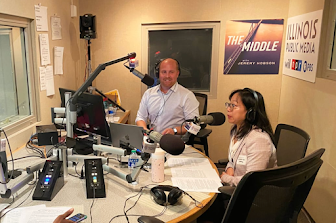 |
| Old school buses help get melons from the farm to the table. (Photo by Edwin Remsberg, Ambrook Research) |
Gas. Electricity. Flintstones footwork. There are many ways to get vehicles going, but some truckers are getting behind hydrogen. The element is "gaining a following among some heavy-duty truck operators who see it as the industry's best path toward zero-emission technology, especially for rigs traveling long distances," reports Paul Berger of The Wall Street Journal. "Hydrogen offers longer trips and faster refueling than battery-cell technology, supporters say, while allowing trucks to haul heavier loads because they aren't carrying industrial-scale batteries."
 |
| Thank you American farmers. (Photo by M. Sullivan Wirecutter) |
 |
| The Mobile Farm Market gets fresh food to grocery deserts. (ILSR photo) |
Living in a food desert creates grocery challenges, especially for those lacking transportation. "When a new mobile grocery market launched in Wayne County, Pennsylvania, its first stop was Maple City Apartments, a 40-unit complex for low-income, elderly relatives. Maple City's residents have felt the region's lack of grocery stores acutely," reports Kennedy Smith for the Institute for Local Self-Reliance. "The county's residents can now buy groceries from a farmers market on wheels. It started when the Cooperage Project, a regional nonprofit organization, wanted to get fresh, healthy food to people during the pandemic. . . .Cooperage created Mobile Farm Market — a small, refrigerated van — to bring fresh produce, milk, cheese, and eggs to towns and neighborhoods lacking full-service grocery stores."
 |
| People with no desire to work the land are purchasing farms. (Photo by Zach McNair, AR) |
Take a peek at Instagram, and "you'll be hard-pressed to escape romanticized images of farm life: rolling hills, broad wrap-around porches, oddly clean baby goats," reports Nora Neus for Ambrook Research. "The popularity of the farm aesthetic and farmhouse lifestyle is creating real estate problems among working farmers, especially younger and newer ones who already face challenges in finding affordable land across the country. . . . Farmhouse properties are so pretty, they're getting too expensive to use for agriculture."
























